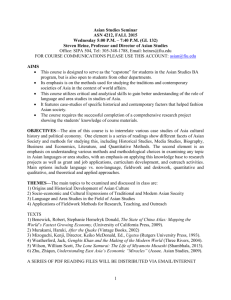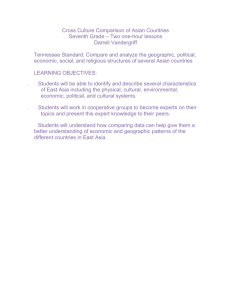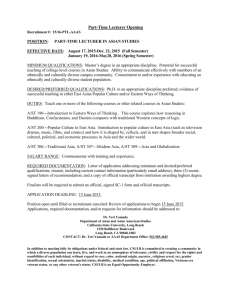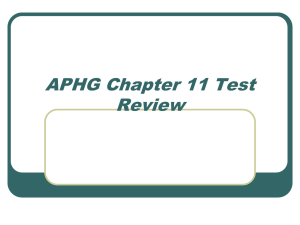ASIAN CULTURAL VALUES IN BUSINESS
advertisement
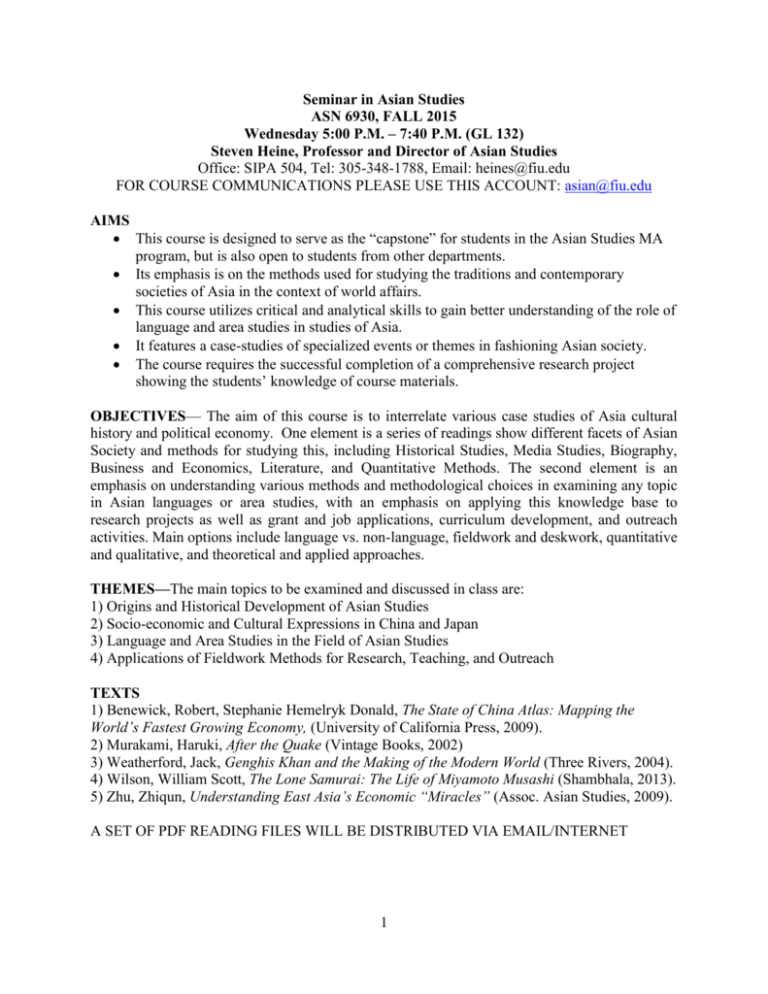
Seminar in Asian Studies ASN 6930, FALL 2015 Wednesday 5:00 P.M. – 7:40 P.M. (GL 132) Steven Heine, Professor and Director of Asian Studies Office: SIPA 504, Tel: 305-348-1788, Email: heines@fiu.edu FOR COURSE COMMUNICATIONS PLEASE USE THIS ACCOUNT: asian@fiu.edu AIMS This course is designed to serve as the “capstone” for students in the Asian Studies MA program, but is also open to students from other departments. Its emphasis is on the methods used for studying the traditions and contemporary societies of Asia in the context of world affairs. This course utilizes critical and analytical skills to gain better understanding of the role of language and area studies in studies of Asia. It features a case-studies of specialized events or themes in fashioning Asian society. The course requires the successful completion of a comprehensive research project showing the students’ knowledge of course materials. OBJECTIVES— The aim of this course is to interrelate various case studies of Asia cultural history and political economy. One element is a series of readings show different facets of Asian Society and methods for studying this, including Historical Studies, Media Studies, Biography, Business and Economics, Literature, and Quantitative Methods. The second element is an emphasis on understanding various methods and methodological choices in examining any topic in Asian languages or area studies, with an emphasis on applying this knowledge base to research projects as well as grant and job applications, curriculum development, and outreach activities. Main options include language vs. non-language, fieldwork and deskwork, quantitative and qualitative, and theoretical and applied approaches. THEMES—The main topics to be examined and discussed in class are: 1) Origins and Historical Development of Asian Studies 2) Socio-economic and Cultural Expressions in China and Japan 3) Language and Area Studies in the Field of Asian Studies 4) Applications of Fieldwork Methods for Research, Teaching, and Outreach TEXTS 1) Benewick, Robert, Stephanie Hemelryk Donald, The State of China Atlas: Mapping the World’s Fastest Growing Economy, (University of California Press, 2009). 2) Murakami, Haruki, After the Quake (Vintage Books, 2002) 3) Weatherford, Jack, Genghis Khan and the Making of the Modern World (Three Rivers, 2004). 4) Wilson, William Scott, The Lone Samurai: The Life of Miyamoto Musashi (Shambhala, 2013). 5) Zhu, Zhiqun, Understanding East Asia’s Economic “Miracles” (Assoc. Asian Studies, 2009). A SET OF PDF READING FILES WILL BE DISTRIBUTED VIA EMAIL/INTERNET 1 SCHEDULE 8/26 (Week 1) 9/2 (Week 2) 9/9 (Week 3) 9/16 (Week 4) 9/23 (Week 5) 9/30 (Week 6) 10/7 (Week 7) 10/14 (Week 8) Introduction to Asian Studies Themes & Methods: PDF readings posted Historical Translation: “Methods” PDF Folklore: Film, “Ugetsu,” with discussion of symbolism plus PDF Literature: Murakami, After the Quake Silk Road Biography: Weatherford, Genghis Khan plus PDF Western Interpreter Biography: Arthur Waley PDF Early Modern Biography: Wilson, The Lone Samurai Fieldwork: “Field Work” PDF REQUIRED: Research Topic Due (1-page Abstract with Bibliography) 10/21 (Week 9) Modern Business: Zhu, Understanding East Asia’s Economic “Miracles” 10/28 (Week 10) Quantitative Studies: Benewick, The State of China Atlas 11/4 (Week 11) EXAM 11/11 (Week 12) NO CLASS VETERANS DAY 11/18 (Week 13) Final Presentations 11/25 Week 14) Final Presentations 12/2 (Week 15) Final Presentations 12/9 (Week 16) Final Presentations FINAL PAPERS DUE December 11 REQUIREMENTS 1. ORAL PARTICIPATION IS AN ESSENTIAL INGREDIENT (10 percent). 2. There will be a weekly one-page assignment based on readings (20 percent) a. This assignment will be graded check plus, check, check minus, or zero. + 0 b. More than one zero or two check minuses will affect final course grade. 3. Each student will make a presentation of one of the weekly assignments (20 percent). 4. 1 in-class exams one hour each (20 percent each). 5. Final research paper (Graduate: 15 pages plus notes/bibliography/appendices) with PowerPoint presentation of the project (30 percent). This paper is in place of a final exam. The research paper should include: 1) Proposal of the topic due mid-semester with outline/abstract and bibliography. 2) Final paper with a clear statement of purpose that demonstrates the use of various interdisciplinary methods in a research project of choice approved by the professor. 2) Solid research skills, including both historical and theoretical components. 3) Illustrate possible applications of research for career planning and grant writing. 4) PowerPoint giving overview of research for final in-class presentations. Grade Scale 92-100 A, 90-91 A-, 88-89 B+, 82-87 B, 80-81 B-, 78-79 C+, 72-77 C, 70-71 C-, 60-69 D ATTENDANCE/PARTICIPATION POLICY STRICTLY ENFORCED A constructive classroom atmosphere where there is a genuine give-and-take between a teacher and students is one of the most valued aspects of the educational process. This takes place 95% of the time, but to ensure that it takes place 100% of the time, the following policies are in effect: 1) In a required class that meets once a week, all students are expected to attend every class for the full class period, but are allowed one (1) unexcused absence. 2 2) Coming more than a few minutes late or leaving early will be counted as an absence. 3) Any absence that is not a documented medical or legal item is “unexcused.” 4) More than one unexcused absence will directly affect the final course grade. No exceptions! 5) Leaving class early without a proper excuse will automatically be counted as a double absence (this includes leaving if there is a break). 6) Any behavior that is distracting, disruptive, or disrespectful will also have a double deduction. 7) Assignments not completed on time will be accepted only by permission of the instructor. 8) No laptop or cell phone usage without explicit permission of the instructor. GUIDELINES FOR ORAL PRESENTATIONS 1) Be sure to use a “critical” methodology by highlighting the main issues in analytic and constructive fashion. 2) Prepare a 10-minute PowerPoint by consulting outside sources that are substantial (not limited to internet). 3) Do not merely summarize, and do not read from outline or PowerPoint. 4) Pose questions for discussion (though do not necessarily try to lead this). 5) TIME LIMITS WILL BE STRICTLY ENFORCED 3 CRITICAL METHODOLOGY FOR RESEARCH IN ASIAN STUDIES Objects of Study People – individual or group Place – natural or manmade Institution – formal or informal Text – classical or vernacular Event – recorded or unrecorded Hermeneutic Circle of Understanding and Appropriating an Object of Inquiry Phenomenology: Subjectivity vs. Objectivity, Participation & Observation – Reflexivity History I: Fact in relation to Facticity; Historicity (vs. Hagiography) to Historiography History II: Situating in Pre-modern vis-à-vis Modern setting East Asian Context of shared language, Confucian and animistic worldview, social identity Transnational/Comparative/Global: Universality related to Uniqueness of Situation/Phenomenon Gemba 現場 Goals and Aims of Scholarship and Pedagogy Thesis – proposal, content, annotations, submission, revision, publication, reviews/rebuttal Conference Presentation – Oral, Written and Delivery skills (PPT or Poster session) Grant Proposal Writing – Identifying Opportunities and Application Process Course Syllabus – Basic and Enhanced versions Policy Briefing – Ability to Communicate and Summarize/Synthesize information and analysis Community Service – engagement with organizations and associations Translation – commercial and scholarly projects 4

